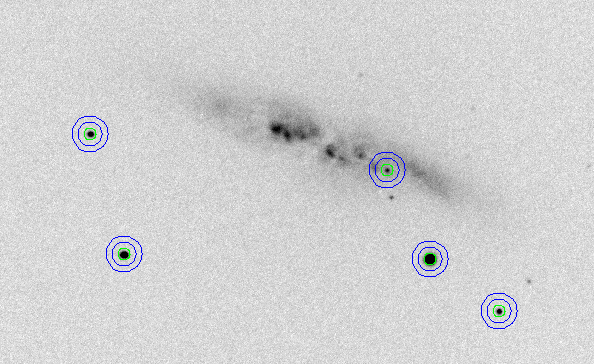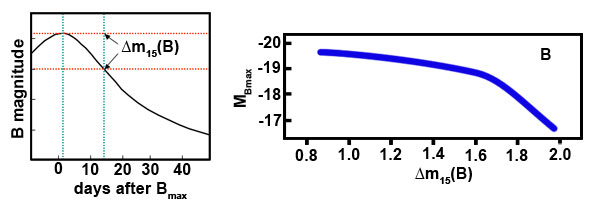SN2014J
Things that go Bang in the Night
Introduction
On 2014 January 21 a new supernova (SN2014J) was discovered in M82 – a very nearby (~3.8 Mpc) star-forming galaxy. The image set below (from Thomas Becker) illustrates the appearance and fading of SN2014J. This was a Type Ia supernova (SNIa) and was the closest supernova of this type discovered in the past few decades.

SNIa are characterized by the lack of H in their spectrum. They result from a carbon-oxygen white dwarf (WD) in a close binary system accreting mass above the Chandrasekhar limit (1.4 solar masses). The nature of the donor star is still disputed: Single Degenerate (WD + Main sequence or Red giant or He star companion) vs Double Degenerate (WD + WD merger) scenarios or both.
SNIa are standard candles (after corrections for a “stretch factor”, luminous SNIa fade slowly and less luminous SNIa fade fast) and can be used to measure the distance to their parent galaxy. At peak brightness, SNIa have a high luminosity and thus can be observed out to high redshifts. The study of very distant (z~0.5) SNIa led to the discovery of the acceleration of the expansion of the universe (dark energy).
CCD images of SN2014J have been taken using the AstroLab telescopes on the Physics department roof, in order to measure the light curve in three photometric bands (B, V, r). Our first observation was made on 2014 January 23 (see image below) and the last observation was made on 2014 May 21. Hence we currently have a dataset covering ~120 days. In the V-band SN2014J reached a peak brightness in early February.

Project Aims
The project goal is to analyse the Durham image data of SN2014J and derive the various characteristics of this SNIa. This will include determining the light curve (in three bands), measuring the peak brightness and decline rate, deriving extinction from colour information, estimating the Hubble constant by reference to a local (z~0.03) SNIa sample and linking the results with on-going studies.
Background
Messier 82 (M82) is a remarkable galaxy. Usually classified as irregular, M82 is a very dusty distorted edge-on disk galaxy. M82 has high star-forming activity and is a prototype member of the class of starbursting galaxies. M82’s distance is estimated to be 3.77 ± 0.66 Mpc (from TRGB and PNLF measurements). M82 is also a member of the M81 galaxy group. The distance to M81 has been determined, via measurements of Cepheid variables, to be 3.63 ± 0.34 Mpc (see Freedman et al, 1994, ApJ, 427, 628 ).
Hubble’s law describes the observed linear relation between velocity and distance that is found for galaxies, i.e.
v = H0 d,
where v is the recession velocity in km/s, d is the distance in Mpc and H0 is the Hubble constant in km/s/Mpc. For studies in the nearby universe we assume v = czCMB, where c is the velocity of light and zCMB is the redshift. The CMB subscript refers to z being measured in the local Cosmic Microwave Background rest frame; see this NASA NED page for more details. We use the term “Hubble flow” to describe the “motion” of galaxies due solely to the expansion of the Universe.
For M82 czCMB is 282 km/s and hence the simpleminded astronomer might derive a value for the Hubble constant (czCMB/d) of (282/3.77) = 75 km/s/Mpc. What Hubble constant would this simple method give if data for M81 was used?
As the distance to M82 is relatively well established, apparent magnitude measurements of SN2014J will allow the absolute magnitude (M) of this SNIa to be determined via the distance modulus equation, i.e.
m − M = 5 log10 d − 5
where d is the distance (in parsecs) and m is the apparent magnitude. This in turn when referenced to a SNIa sample in more distant (but relatively local) (z~0.03) Hubble flow allows a measurement of the Hubble constant to be made.
Project Notes
The key stages of the project will include:
- review of SNIa and the extragalactic distance scale, e.g. how are SNIa made standard candles?; what are current best estimates of the absolute magnitude of SNIa?, why is the simpleminded astronomer’s measurement of the Hubble constant naive?
- review of SN2014J and on-going studies, e.g. background to the discovery of SN2014J; what are on-going studies trying to determine?
- photometric measurements from the Durham CCD image data, choice of aperture sizes and calibration stars?; how well do the Durham measurements agree with other sources?
- construction of BVr light curves and comparsion with other SNIa light curves; from the light curve is SN2014J a Type Ia supernova?
- determination of peak brightness in B-band and Δm15(B); what are the uncertainties on these parameters?
- estimation of the extinction foreground to SN2014J in M82 via (B-V) colour information; how well can this be determined?
- link the SN2014J characteristics to a more distant sample of SNIa in the Hubble flow to determine H0; uncertainty of the value derived?
- compare and contrast the results obtained with other on-going studies.
CCD Image Data and Photometric Measurements
The differential photometric measurements will be made via aperture photometry using Peter Draper’s GAIA image display tool by reference to two carefully selected calibration stars in the images. The primary source of the CCD images for the project will be from our DRACO2 telescope.
DRACO2 is a 14-inch Meade LX200 telescope housed in a 6-foot Technical Innovations dome on the roof of the Physics Department. DRACO2 has a QSI 683ws CCD with a filter wheel (B, V, r). The CCD field-of-view is 18 x 13 arcmin and the pixel scale is 0.99 arcsec per pixel (with 3×3 binning). DRACO2 is controlled by a set of python scripts running on a Linux workstation (Fedora) in the dome. The SN2014J observations with DRACO2 were carried out by Astrolab Staff and Level-3 students.
Select suitable images for analysis from the DRACO2 2014 observing logs.
While the uncertainty on your instrumental magnitude measurements is provided by GAIA (see the section of “Calculation of the errors” in Starlink’s SUN45), the formal way to estimate these uncertainties is given in John Simonetti’s Measuring the Signal-to-Noise Ratio S/N of the CCD Image of a Star.
Use Modified Julian Day (MJD) to record the date/time of an observation. The MJD is defined as
MJD = JD – 2400000.5,
where JD is the Julian Day. Start of the JD count is from 0 at 12 noon 1 JAN 4712 (4713 BC). On a linux workstation use the command
/remote/aa_64bin/mjday
to find the MJD from a calendar date.
References
- 101 Photometry
- Wikipedia SNIa
- Distance to M82 as reported at NASA NED.
- Wikipedia SN2014J
- Supernovae 2014J in M82 page at Rochester.
- AAVSO Light Curve Generator page on SN2014J (aka PSN J09554214+6940260)
- Estimating the First-light Time of the Type Ia Supernova 2014J in M82, Zheng et al. (2014, ApJ, 783, 24)
- The Rise of SN 2014J in the Nearby Galaxy M82, Goobar et al. (2014, ApJ, 784, 12)
- Supernova 2014J at maximum light, Tsvetkov et al. (2014, arXiv:1403.7405)
- Phillips relationship, see Phillips ( 1993, ApJ, 412, 105 ).

- Selection Effects, Biases, and Constraints in the Calan/Tololo Supernova Survey Hamuy & Philips (1999, AJ, 118, 1185), Table 1 has a dataset of [redshift (cz), M(BMAX), Δm15(B)] for a SNIa sample in the Hubble flow.
- Type Ia Supernova Light Curve Inference …, Mandel, Naratan & Kirshner (2011, ApJ, 731, 120) provide a compilation of 127 local SNe Ia (see Table 4 and 5). For this project the key diagram is Figure 4. Their dataset is available online at VizieR.
- Type Ia Supernova Light Curves
- Type Ia Supernovae as Standardized Candles
- The progenitor of a Type Ia supernova
- Measuring Interstellar Extinction
- The Peculiar Extinction Law of SN 2014J …, Amanullah et al. (2014, ApJ, 788, 21)
- Wikipedia Hubble’s Law
- The 1% Concordance Hubble Constant, Bennett et al. 2014, arXiv:1406.1718.
